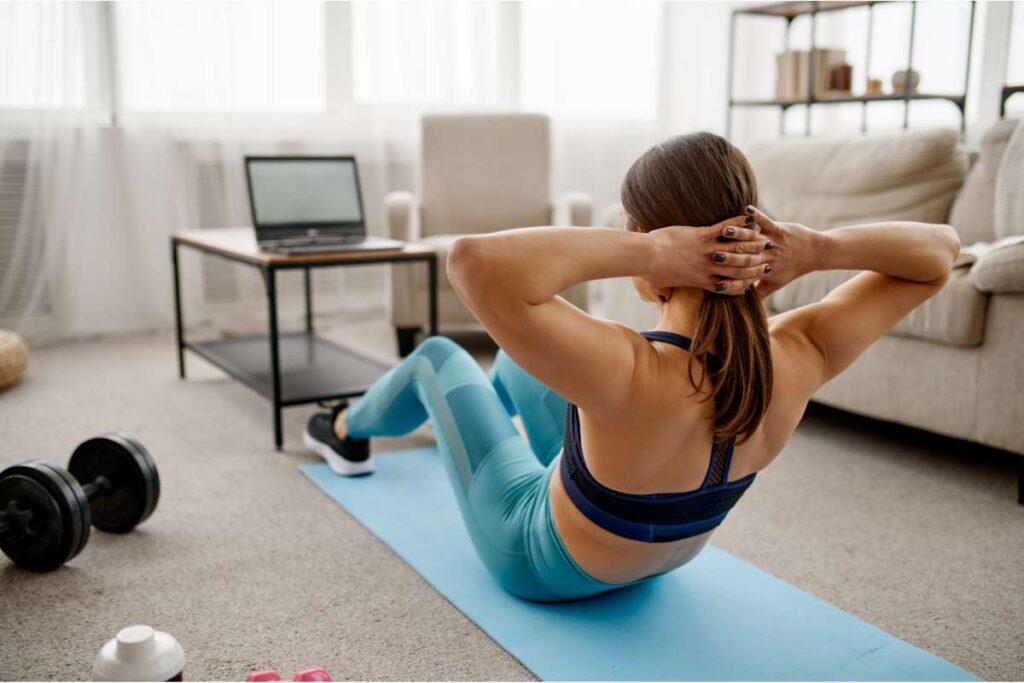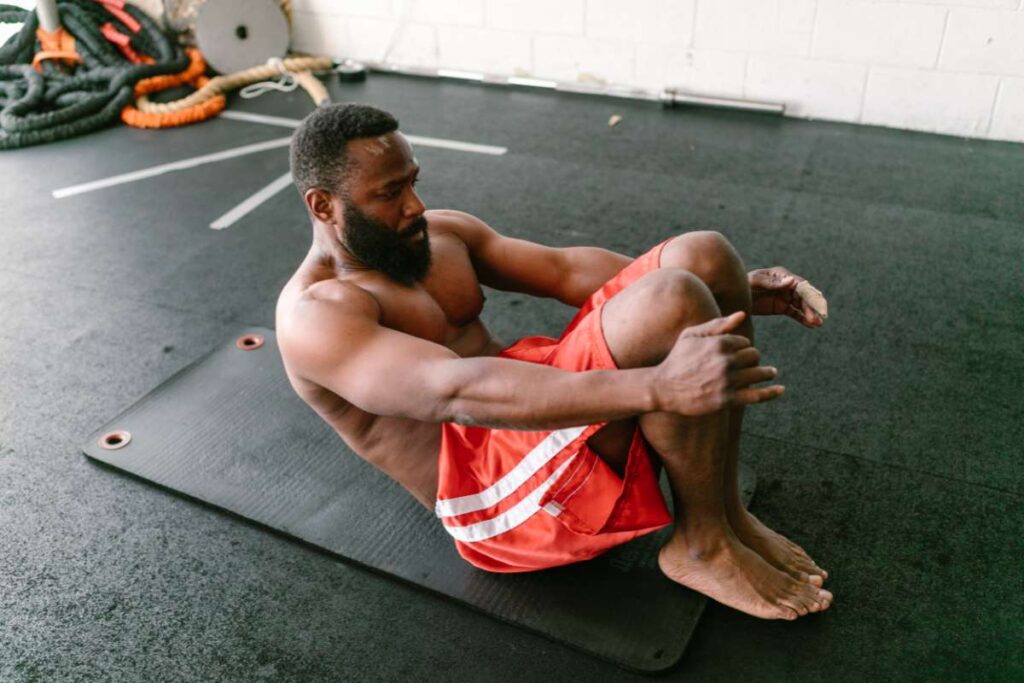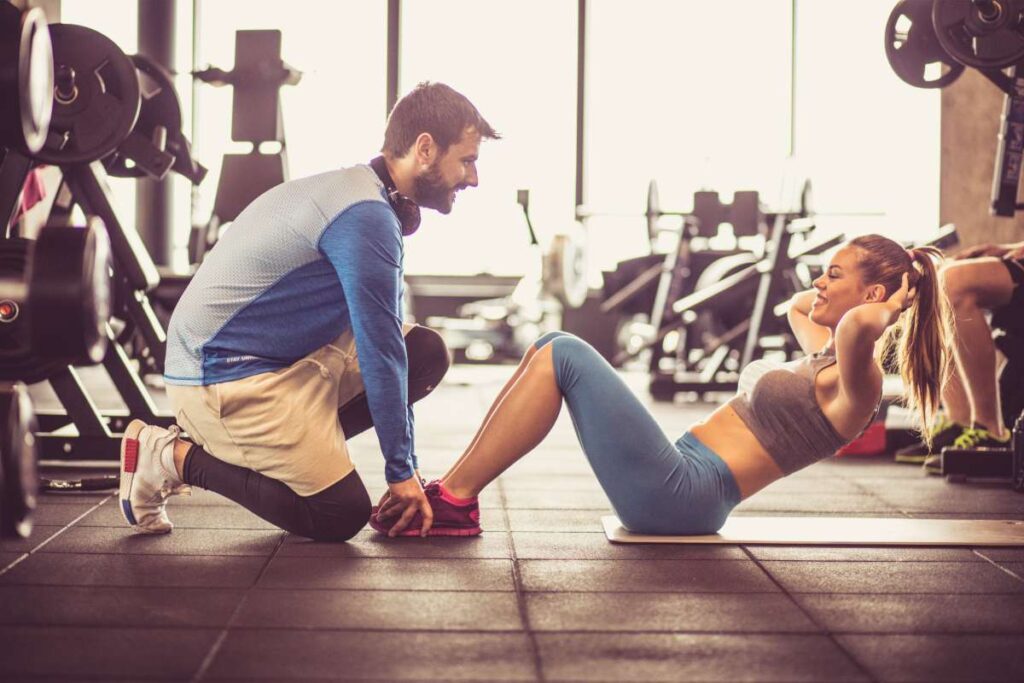This post may contain affiliate links at no additional cost to you. As an Amazon Associate I earn from qualifying purchases. Click to view our full disclosure.
What's inside
How many sit ups a day should you do to see results?
It may be a lot less than you think. In fact, just 50-100 sit ups a day may be enough. The catch is, you also need to cut calories while increasing your protein intake.
As a professional trainer, my clients frequently list ripped abs as a main goal. But doing an exercise like sit-ups is just one piece of the ab-shredding puzzle.
Today, let’s discuss how many sit ups a day you should do to see results. We’ll break down the muscles worked, how to perform them, and pro tips to maximize those gains.
Let’s dive in.
How many sit ups a day should I do to see results?
Related: How To Burn 1000 Calories Per Day

Fifty to 100 sit ups a day is sufficient to see results. However, you must also be in a calorie deficit, eating high-quality, nutrient-dense foods rich in protein.
Your 50-100 sit-ups can be divided between three to four sets. You can take rest breaks of 30-60 secs between sets to make the goal more achievable.
What are sit ups?
Sit-ups are an abdominal exercise where the participant will lie in the supine position with knees bent at 90 degrees. From there, they lift their upper body up toward the knees in a straight line.
Sit-ups target and strengthen the abdominal muscles and can help you lose weight due to the energy expended during the exercise.
However, doing this alone will not help you spot reduce fat or weight from the abdomen. To achieve weight loss, you need a caloric deficit.
What muscles do sit ups work?
Related: The Complete Calisthenics Workout Plan With PDF
Before we get into how to perform our sit-ups and cover the benefits, let’s discuss the anatomy.
This will help you understand the muscles you are targeting and help you build that mind-muscle connection, improving contractions with every rep.
| Muscle | Function |
| Rectus Abdominis | Flexes trunk, compress abdominal organs |
| External Obliques | Rotates and flexes trunk |
| Internal Obliques | Rotates and flexes trunk |
| Transverse Abdominis | Compress abdominal organs, support trunk movement |
Do sit ups work?
Yes, sit-ups do work if they are done correctly. Perform the movement with the abdominals, focusing on contracting the target muscles through the full range of motion.
To increase effectiveness, focus on exhaling and drawing your belly button to your spine while tensing your abs as you lift your torso off the floor.
This will improve your ability to target your abs and improve your results.
How To Do Sit Ups
Related: Full Body Workout Every Other Day
Now that we have covered the anatomy, it’s time to go through how to perform a sit up correctly. Correct form is the difference between a sore back and toned core.
Equipment Required
- Mat
- Floor Space
How To Perform Sit-Ups
- Lie down on the mat on your back.
- Place your feet on the floor with your knees bent at 90°.
- Position your hands across your chest.
- Begin by lifting your back up off the floor until your torso is 90° off the floor.
- Once at the top, lower back down to the starting position. Repeat.
Benefits
- Increase abdominal muscle mass
- Strengthens abs
Pro Tips
- Exhale, tense abs, and draw your belly button toward the spine as you lift your torso off the ground. This will help you contract your target muscles.
- Perform the sit-up with control and keep your feet firmly on the floor for the duration of the set.
Benefits of Doing Sit Ups

Doing sit ups is not just a great way to carve out and build a lean set of abs. Here are my top reasons why you should consider performing sit-ups as a part of your training routine.
Strengthens Your Core
Doing sit-ups helps strengthen core muscles such as the rectus abdominis, obliques, and transverse abdominis.
By performing sit ups with nothing more than your own body weight you will be overloading to promote muscle hypertrophy.
Research suggests that performing sets of eight to 12 repetitions at 60%-80% of your one repetition maximum (1RM) will increase mass. Sets of one to five reps at 80%-100% will increase strength.
With time and dedication to form, this can reduce the likelihood of back pain and improve your posture.
Increased Endurance
The previously mentioned study suggests that completing sets of 15+ repetition at 60% or less of your 1RM will help improve endurance.
This can be particularly helpful to improve performing in the gym, sport, and in daily life. Whether your job is physically demanding or you’re trying to improve your run time, sit-ups help you get it done.
Improved Performance
Studies indicate that undergoing core training can help to improve stability and stiffness of the spine.
Which allows us to reduce areas of weakness in our movement when performing athletic movements or shifting external loads.
Improve Function
The benefits of sit-ups are not only aesthetic, as they are a great way to build a mind-muscle connection with your abdominals, improving overall function and safe movement.
After all, the stability of your core assists you in sitting up and down, lifting objects, and so much more.
This, combined with the benefits for endurance and performance, sets you up for more years of healthy everyday mobility.
Enhances Physique
While this will largely come down to your nutrition and the reduction of body fat, regular sit-ups can help to carve out your abs. After the fat is gone, you want muscle to show beneath, so sit-ups are half of the equation.
When done properly, they can help narrow your mid section, giving you that lean, athletic look.
How many sit ups a day should I do?

The number of sit-ups a day you should do is based on your experience level.
Beginners can start small with a range of two to three sets of 10 repetitions.
Intermediate and advanced-level lifters should aim for four to six sets of 15-20 reps. However, this number can vary based on the individual.
The number of sit-ups you would need to do to get abs really comes down to your nutrition and being in a calorie deficit.
It cannot be overstated – there is no such thing as spot reduction. While you may be burning calories performing hundreds of sit-ups, no amount of ab workouts can out-train a bad diet.
The correct approach here is to eat nutrient-dense food and fewer calories.
To find help you get into a caloric deficit, use our advanced calorie and macronutrient calculator.
Simply add your age, gender, height, weight, and activity level to receive a precise calorie target to get you into a deficit and help you achieve lean, cut abs
Results of Doing 100 Sit Ups a Day for One Month

There is no doubt that performing sit-ups daily will alter your abdominal strength and physique. But what would happen if you did 100 sit ups a day for one month?
Here’s what to expect from doing sit ups everyday for a month.
Week 1
Your first day of performing 100 sit ups will feel like a challenge, especially if you have not done that many in the past.
Whether you are smashing them out in chunks of 25 or smaller blocks of 10, you will likely feel the burn as your muscles fatigue with each subsequent set.
The following day will likely leave you with sore abs. The bonus here is that you will be able to feel them and actively contract them.
The second day will feel a little more challenging due to fatigue and muscle soreness. However, this will pass as the week goes on and your endurance and technique improve.
By the fifth to seventh day, you will begin to notice definition through your core as the muscles will seem like they are contracting.
And if you have been following a calorie deficit, you hopefully be able to notice your upper abs become a little more defined.
Week 2
Heading into week two, your technique and efficiency should have made a huge leap.
You will be comfortably pumping out sets of 15-20 reps with smaller rest breaks. The slight DOMs (delayed onset muscle soreness) will help build an excellent mind-muscle connection.
This adds to not only your ability to contract your abs on cue during daily activities, but during your sit-ups, boosting the quality of each rep.
As the week progresses, the definition of your upper abdominals will increase while your mid to lower abs will begin to show definition.
Week 3
Week three is where the routine of performing 100 sit ups becomes natural, as you can easily perform blocks of 20-25.
You may feel your upper abs are becoming rock solid, while your mid to lower abs are really starting to lean out.
It is by now that you should really start to notice the difference having a strong, functional core makes. Here, your abs involuntarily activate when moving around, lifting objects and getting up and down from the seated position.
This daily involuntary contraction will also result in a slight narrowing of your waistline, as your transverse abdominis is always on standby to keep your core tight for the next movement.
Week 4
By week four, your technique and proficiency make the act of 100 sit ups a day seem almost effortless.
If 10-15 reps in the first week seems like nothing, you are easily able to knock over sets of 20-25.
Your sit-ups now feel more like an activation routine, leaving you with little fatigue or soreness. They serve more as a wake-up to your abs to get them prepped for the day’s activities.
Plus, if you have been following your calorie deficit, your upper and middle abs will be on full display, with your lower abs well on the way.
How many calories do sit ups burn?
Each sit-up burns around 0.2-0.5 calories. If you were to perform 50 sit ups in a minute, you would burn roughly 10-25 calories.
Crunches vs. Sit-Ups

So, while we are going through all of this you’re probably wondering, what is the difference between crunches and sit-ups?
While they both target the core, the way they are performed makes them different exercises.
Crunches vs. Sit-Ups: A Comparison
| Crunches | Sit Ups | |
| Target Muscles | Rectus Abdominis, Obliques, Transverse Abdominis | Rectus Abdominis, Obliques, Transverse Abdominis, Hip Flexors |
| Range of Motion | Minor Thoracic and Lumbar Flexion | Spinal Flexor, Hip Flexion |
| Lower Back Strain | Less | Greater |
| Difficulty | Easier | Greater |
Target Muscles
The target muscles remain largely the same as they both require a degree of spinal flexion, contracting the abs.
However, due to the fuller flexion at the hips of a sit-up that lifts your torso completely off the floor, you may notice great activation of the lower abdominal fibers and even the hip flexors.
Range of Motion
The clear difference between the two is the range of motion. Crunches only require a slight lift of the shoulders and upper back off the floor.
Meanwhile, sit-ups require full hip flexion and lifting the upper half of the body.
Lower Back Strain
One of the major differences between the crunch and sit-up is the pressure that it can put on the lower back.
The crunch’s shorter range of motion leaves less room for error, decreasing the strain on the lower back compared to the sit-up.
The greater range of motion seen in the sit-up, with the flexion of the spine, can put a strain on the lower back if not performed correctly.
This typically happens when we begin to fatigue and attempt to use momentum to lift ourselves up and fall back to the floor.
To avoid straining the lower back, exhale and engage the core. Perform every sit-up with control and never rush it.
This will improve core activation and contraction, reducing the chance of injury.
Difficulty Level
Traditionally speaking, sit-ups are the more difficult of the two exercises.
The greater range of motion requires a greater level of control and amount of time your abs are contracting. However, this is purely based on the individual and their personal preference and proficiency of the exercise.
Pro Tips for Doing Sit Ups Effectively

Getting a great set of abs takes more than just getting on the ground and doing sit-ups every day. It takes correct breath work and solid ab activation.
Here’s my list of professional tips to help you nail your sit-up routine.
Use Proper Form
Like with all exercises, sit-ups should be performed with correct technique. This is not only to avoid injury, but to get the most out of each rep.
To do this, focus on lifting and lowering the torso in a controlled manner, avoiding the use of momentum. Avoid hunching or letting your shoulders pull forward to get you there faster.
Breathe Properly
One of the best ways to improve your core activation is by controlling your breathing.
Studies indicate that core muscles are essential to effective breathing, as exhaling is performed by both our diaphragm and abdominal muscles.
What this means is that exhaling at the beginning of each rep will naturally be engaging and contracting the abs, increasing the activation and stability of your core.
The right breath pattern helps you to take better control and improve the quality of every rep.
Focus On Contractions
While completing a sit-up and going through the full range of motion will target the abs, it doesn’t necessarily guarantee you are landing each rep.
By focusing on your breathing, exhaling as you lift up, drawing the belly button to spine and engaging your core, you ensure you are making each rep count.
This also helps to strengthen that mind-muscle connection that will not only help you get better results, but improve your ability to recruit during other lifts and daily activities.
Start Slow
One of things that many people do when they set out to get a six pack is program these huge ab routines consisting of many different exercises and high reps.
And while they will get you results, they can make it difficult to stick to – especially if you lack experience or struggle with consistency.
When you are thinking of doing sit ups everyday, the key is to take it slow. Start with smaller rep ranges and focus on the quality of those reps.
This will not only help you get those rock-hard abs, but it will reduce the chances of burn out.
Rest and Recover
When it comes to doing 100 sit ups a day, one of the most important things to consider is what you do when you’re not exercising.
While your abs are robust and can be hammered most days, they still need ample rest to help replenish energy stores and build lean muscle tissue.
By scheduling a couple of rest days each week, you will not only give your body a much-needed rest. You will also help your mind refresh and allow you to tackle you next week head on.
Final Thoughts
There is no doubt that doing sit ups every day will help you strengthen and develop leaner, more muscular abs.
However, to maximize your results and see major changes, proper form, a focus on contractions and correct nutrition are key.
Doing this will ensure that you are increasing core muscle mass and reducing total body fat on your way to a lean and sculpted midsection.
So, have you had trouble performing ab workouts in the past? Are you considering trying for 100 sit ups a day?
Let us know in the comments.
Do sit ups burn belly fat?
Sit-ups will burn calories that will help to burn belly fat. However, sit-ups alone will not reduce belly fat as there is no such thing as spot reduction.
To effectively lose belly fat, you will need to be in a calorie deficit to ensure you are expending more calories than you are consuming.
What is a good amount of sit-ups to do a day?
Between 30 and 50 sit-ups a day is a good number to perform. However, this comes down to the individual and their experience level with abdominal training.
While 30-50 repetitions may be challenging to a novice with little abdominal conditioning, it may not be enough to overload and stimulate the fibers to promote growth.
Will 20 sit-ups a day tone my stomach?
Yes, 20 sit ups a day will contribute to toning your stomach. However, this is provided you are also in a caloric deficit which will help you reduce body fat, further revealing your abdominal muscles.
What happens if I do 100 sit-ups a day?
If you are doing 100 sit-ups a day, you will begin to increase abdominal muscle mass and endurance.
Plus, if you are performing them while fueling your body with high-quality, nutrient-dense foods in a calorie deficit, you’ll see reduced body fat around your core, revealing abdominal definition.
How many sit-ups a day to get a six pack?
Around 30-50 sit ups a day will help contribute to building your size pack. This largely comes down to your nutrition, intensity, and your ability to overload your abdominal muscles.
Is 30 sit-ups a day good?
Yes, 30 sit ups a day is good, as any form of exercise on a daily basis should be encouraged.
How many sit-ups a day to get a six pack in 2 weeks?
100 sit ups a day may provide you with a stimulus required to get a six pack. However, the factor that will make the biggest difference is a caloric deficit.
This will ensure you are consuming less calories than you are burning. It will help you reduce total body fat and help you increase abdominal definition.

